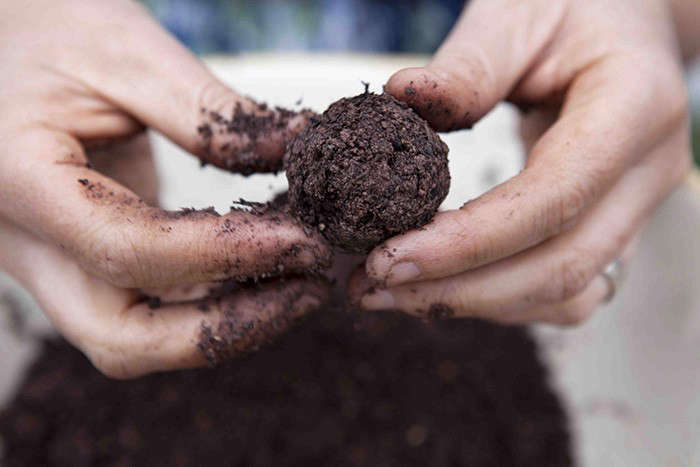Vegetable growers in the UK love their allotments: ornamental kitchen gardens are for other people. With every plot a hymn to recycled chicken wire and corrugated iron, the wartime Dig for Victory spirit is alive and well. Peter Montague, who tends a double plot in Northamptonshire, shows us around:
Photographs by Kendra Wilson.

Above: View of Peter’s sheds from the sizable muck heap. It’s full of unglamourous things like nets and ancient forks, and he doesn’t worry about locking up or even closing the doors: there are none. Leaving anything valuable at an allotment is strongly discouraged, even with security. There is surprisingly little food theft: it is more likely to be shared.
This is how British allotments work: “When you go down there at the weekend, the chances of seeing everyone at work are practically nil,” says Mary, Peter’s wife. “They’re too busy standing around chatting to each other.”
Above: Netted Cavolo Nero, grown from seed in Peter’s greenhouse. “Eat Cavolo Nero within three hours of picking,” advises Peter. “Otherwise it’s foul.” This applies to all kale, cabbage and sprouts.
A retired scientist, Peter explains that brassicas are only a molecule away from mustard gas. Bruising and ageing encourage these types of vegetables to emit an odor, an indelible school memory for many Brits. Grow and harvest them yourself: Cavolo Nero of Tuscany from Seeds of Italy £1.99 per seed packet. For US readers, Grow Italian supplies Kale Cavolo Nero seeds for $3.15 per packet.

Above: A curiously long Brussels sprouts “cage,” running more than half the length of a neighboring plot, with its contents netted against pigeons.
The enthusiasm for sprouts displayed here must bear out Peter’s advice that they taste completely different when they are absolutely fresh and cooked properly.

Above: Just-dug beetroot.
This could become soup so easily if taken indoors, scrubbed, boiled for a couple of hours, skinned, and blended. Keeping the cooking water, add a teaspooon of Dijon mustard, a tablespoon of balsamic vinegar and a dollop of sour cream at the end. Adapted from a recipe in Nigella Lawson’s How to Eat (available in hardcover for $22.84 from Amazon).

Above: Calendula growing around the deer fence. “Pot marigold blooms every day of the year,” Peter reminds us. The summery petals jolly up a winter salad.
Peter’s plot is so prolific that he made up vegetable boxes for his daughters at Christmas and probably could every week. This year each box had: A stalk of Brussels sprouts, cabbage, leeks, celeriac, carrots, beetroot, onion (stored), garlic and shallots (ditto), and herbs: parsley, bay, thyme.
Plus: homemade redcurrant jelly, crab apple jelly, apple chutney.

Above: The allotment backs on to open Northamptonshire country.
These allotments are very picturesque compared with their urban relations and much cheaper, coming in at about £20 ($30) per year in rent. They lack amenities: there is no water supply. Contraptions for conserving water are complicated, and the accepted vernacular is always the shabbier side of chic. It’s deeply uncool to have an expensive-looking shed or even a new one.

Above: In season, spinach beet or “perpetual spinach,” self-seeded. A very hardy relation of spinach and a little rougher: discard the tough center before cooking. Peter’s main source of seeds is The Organic Gardening Catalogue.

Above: Celeriac, pre-trim.
The roots are nigh impossible to clean and are best removed, with the leaves. Dirt is a good preservative, so prepare just before cooking (try roughly chopped and roasted with other roots in olive oil). The leaves are useful for adding to stock in lieu of celery.
Intrigued by celeriac (but a little scared)? Our easy (and delicious) recipe for Celeriac Gratin With Thyme and Gruyere will clear things up.

Above: Peter’s village is dominated by a large parish church and it manages to loom over the allotments as well.
“Little and often,” is Peter’s advice on getting the plot to work for you, with an emphasis on “often.” Less experienced allotmenteers are often unprepared for the work involved in taking on a plot, even when they have been on a waiting list. Older people are in the majority, happy to share their knowledge, while privately marveling that anyone would sign up to tend a 250-square-meter plot (about 2,690 square feet) without knowing how to wield a hoe.
Love the look of Cavolo Nero? Other hardy Italian vegetables for your consideration: Sow Now For Winter Salad.













Have a Question or Comment About This Post?
Join the conversation